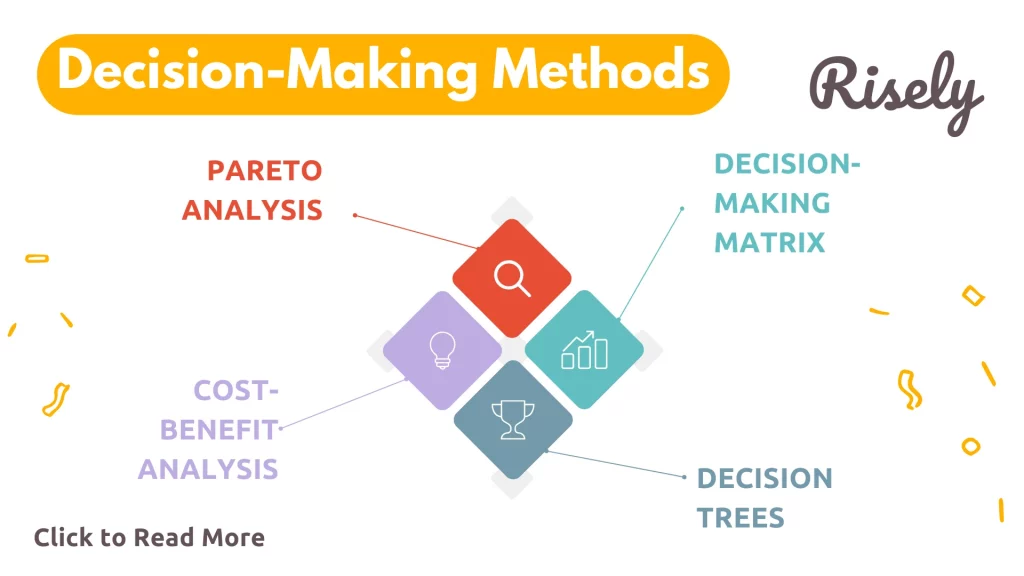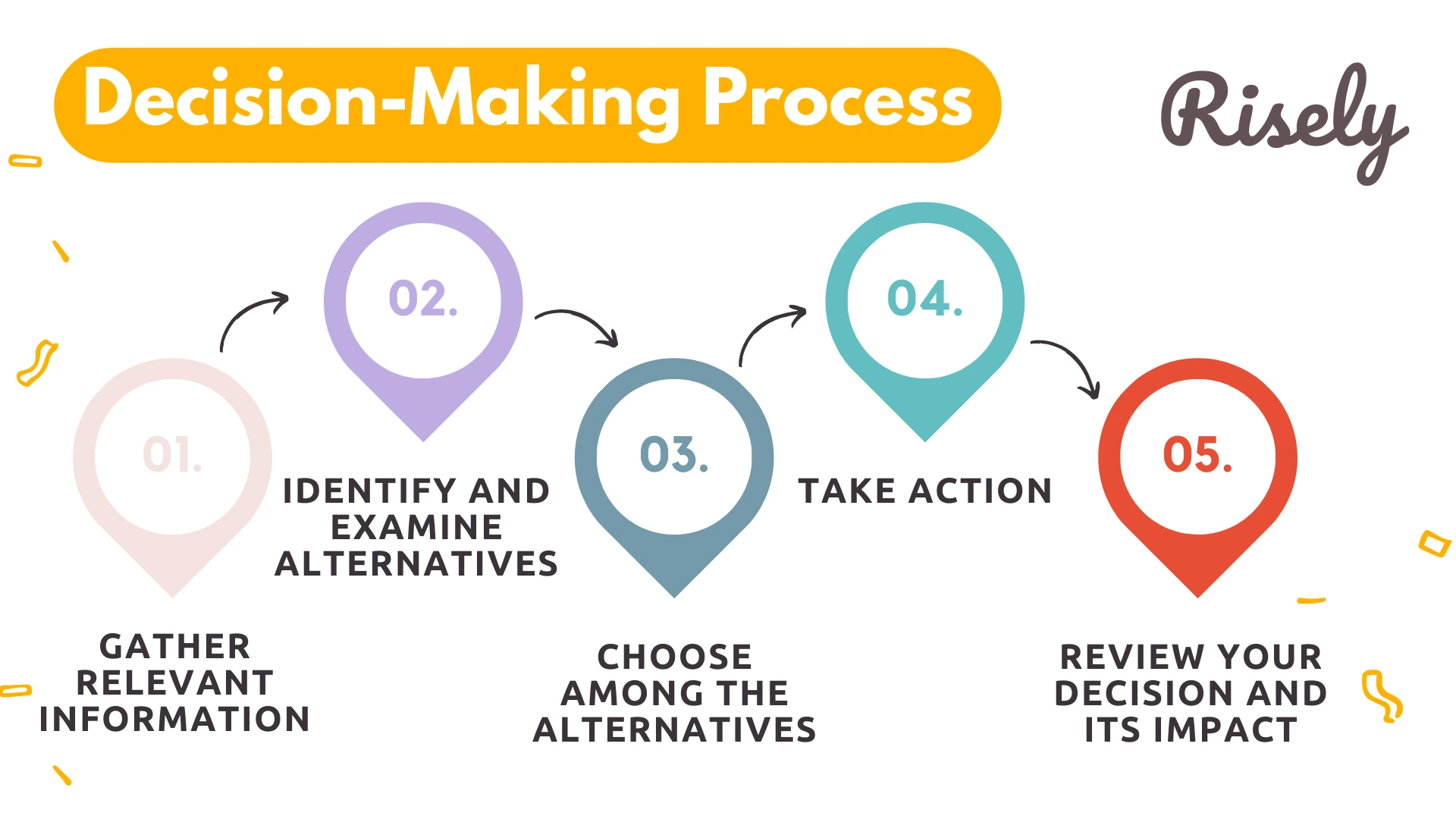5 Steps to Decision-Making Process for Effective Managers
Decision-making is a crucial part of our daily personal and professional lives. It requires careful consideration of the options, their potential consequences, and the ability to choose the best course of action to achieve our goals. The quote by Ken Levine, “We all make choices, but in the end, our choices make us.” perfectly captures the importance of taking the time to make well-informed and thoughtful decisions. In this blog, we will explore the 5 steps of decision-making process and its challenges. These steps to decision-making process provide a structured approach and help ensure that decisions are well-informed, aligned with goals and objectives, and effectively achieved the desired results. However, making decisions is not always easy, but for managers, it comes with more pressure. There are a variety of challenges that can arise during the process of decision-making. Understanding these challenges and how to overcome them is crucial for effective decision-making. Whether you are making a decision for yourself or your team, this blog will provide valuable insights to make informed and effective decisions.What is Decision-Making?
Decision-making is choosing the best action to achieve a specific goal or solve a problem. This process often involves evaluating alternatives, considering the impact on team members, and using available information and data to determine the most appropriate action. Effective decision-making requires strong analytical and problem-solving skills and the ability to consider multiple perspectives and make well-informed choices. In addition, the outcome of the decision can significantly impact the team’s success, so managers need to make decisions systematically and deliberately for the team’s benefit.What are the 5 Steps to Decision-Making Process?
The decision-making process begins when you face a situation where some choices must be made as a manager. But how to make these choices in a way that takes you to the desired results can be described in the following five steps. On each of these steps, there are small things that you need to take care of as a manager, which will eventually add up and make you a successful decision-maker.Step 1: Gather Relevant information
The decision-making process begins with collecting facts and data, which is essential to understand the situation clearly, get an idea of the desired result, and make further analysis. This decision-making step is crucial for ensuring the decision is well-informed and based on accurate and relevant information. Moreover, it allows you to connect with the relevant stakeholders as well. There are many ways to tackle the first step effectively, such as data collection surveys across teams and organizations, utilizing internally generated reports, and observation. You can also seek specialized inputs from senior professionals and industry experts. The key is to focus on having all the details in front of you before heading to the next step.Step 2: Identify and Examine Alternatives
Building on the first step, the second step calls for a list of possible ways ahead. For instance, you want to visit a new eatery near your place. You can take the bus, the subway, or use your own car. For each of the choices, there would be some benefits and costs for you. Gas prices are rising and making you step back from the car. On the other hand, the cheapest of the three, a bus, would take much more time. Comparing the benefits and evaluating the cost like this is the key to making the right choice for your team. This stage requires creative thinking and considering different perspectives and approaches. The goal is to generate as many options as possible to ensure all potential solutions are considered and comprehensively evaluate each option. It requires systematically and thoroughly examining each option, considering prices, risks, benefits, and possible consequences. Read more: How To Improve Analytical Skills As A Manager? All that you need to learn is here!Step 3: Choose Among the Alternatives
Now comes the crucial part of the decision-making process for managers: choosing the most suitable option based on evaluating the alternatives. In this step, managers’ understanding of the team’s goals and priorities and the ability to weigh each option’s potential benefits and drawbacks play a significant role. In addition, the chosen option should be aligned with the team’s goals and values and be the most feasible and practical solution to the problem. There are a few ways to do this; you may or may not unconsciously combine some of them to make daily choices. Let’s understand them briefly:- Pareto Analysis: The Pareto Analysis, also known as the 80/20 rule, focuses on the most crucial aspect of any situation. The method relies on the idea that 20% of action causes up to 80% of the impact. Hence, getting this crucial 20% right is highly important. It can help managers identify the most critical metrics to consider while deciding.
- Cost-benefit Analysis: A cost-benefit analysis shifts managers’ focus from results to the action plans in front of them. It calls for evaluating the efforts needed in each alternative, be it physical, mental, or financial, and sets it up against the impact that can be achieved. Based on such comparison, managers can choose the most tenable alternative that promises to deliver a high positive impact at a low cost.
- Decision-making Matrix: The decision-making matrix is a tool that helps managers evaluate multiple alternatives against pre-determined performance factors. For instance, let’s think of purchasing coffee. You want strong flavor; aroma matters, but the brand name does not so much. Based on these three ideas, you can rank your options and pick the one that fairs best.
- Decision Trees: Decision trees take your mind maps out onto the walls, quite literally. A decision tree involves a graphical representation of your processes and potential paths. It helps visualize outcomes and the challenges that can arise to enable effective decision-making.

Step 4: Take Action
This decision-making step involves putting the chosen course of action into effect. This step requires a clear plan for implementation and the allocation of resources, as well as effective communication and coordination among the team members and manager. Managers should ensure that the decisions are effectively implemented and constantly monitor the processes to identify opportunities for improvement. While you may not get everything right, remaining adaptable and open to reform is the key! Translating the idea into action requires managers to communicate their vision to the team. If a manager shows up one day and sets out a litany of orders out of nowhere, the most likely reaction is confused faces. The right way to handle such changes includes:- Document the decisions along with facts and data supporting them.
- Communicate the decisions in time so that team members can prepare as needed for future changes.
- Be open to questions. Some are bound to rise no matter how many corners you cover. Answer queries, create solutions for concerns, and consistently offer guidance to help your team.
- Explain the why. When things make sense, they are easier to follow. Show your long-term vision to your team, and elucidate the objectives the decision is meant to support. You can create a vision statement to connect with your company’s long-term strategic goals and values. On the other hand, a problem statement can help you support your decision if it is directed toward specific issues.
Step 5: Review your Decision and its Impact
This final step involves assessing the outcome of the decision and determining whether it has achieved the desired results. This step requires ongoing monitoring and evaluation of the results and the ability to adapt and make changes as necessary. The goal is to continuously improve decision-making and ensure that the team achieves its goals and objectives. All in all, as the process comes to a close, there are a few questions that you should be answering to understand its effectiveness:- Did the decision contribute to your objective?
- What was the contribution in terms of specific metrics? Were there some areas that got negatively impacted or neglected?
- How did the stakeholders react? Everyone from middle management signing the papers to the executors – how can the decision be made more platable to them?
- What next?

Let’s Revisit with an Example: The Decision-Making Process for Managers
To enhance their team’s sales performance, the manager diligently followed a structured decision-making process consisting of five crucial steps. Firstly, they gathered information and meticulously examined sales data, market trends, and customer feedback to gain valuable insights. Next, the manager identified and evaluated various options for process improvement. This involved brainstorming and analyzing potential strategies such as refining the sales pitch, expanding the target market, or optimizing the CRM system. After carefully assessing, the manager focused on refining the sales pitch as the most promising option. They believed that clearer communication and value proposition would resonate better with customers. Taking action, the manager initiated training sessions for the sales team, equipping them with improved sales techniques. They also closely monitored the implementation and provided ongoing support. Lastly, the manager regularly reviewed the results and sought feedback from the team. This iterative process allowed continuous improvement, ensuring the sales processes remained dynamic and effective in achieving their goals.Other Interesting Reads
Common Challenges in the Decision-Making Process for Managers
- Misidentifying the situation: This occurs when the manager does not accurately define or understand the problem or opportunity being addressed. This can result in a decision that is not relevant or appropriate for the situation and can lead to ineffective or inefficient outcomes.
- Too much or too little information: Having too much information can be overwhelming and make it challenging to evaluate options and make decisions. On the other hand, having too little information can result in a decision that is not well-informed and may not consider all potential risks and consequences.
- Overconfidence in the execution of the plan: This happens when the manager is too confident in their chosen course of action and does not adequately consider alternative options or potential risks and challenges. This can result in a decision that is not well thought out and can lead to unintended consequences.
- Impulsiveness: It takes place when a decision is made without sufficient thought or consideration and is often based on emotional or knee-jerk reactions. Impulsive decisions can be short-sighted and incompatible with the team’s goals and objectives.
Beating the Decision Blues – Is your Decision Making Process Effective?
To overcome these challenges, it is essential to use a structured and systematic approach to decision-making, gather accurate and relevant information, and critically evaluate options and potential consequences before making a decision. Now, what do good decision-making processes look like, here’s a few hints:- Good decisions are clear and understandable for others.
- Facts and data inform good decisions.
- Good decisions are made at the right time and consider multiple stakeholders.
- They account for changes in plans and adapt to varied needs.
Conclusion
In conclusion, the 5 steps of the decision-making process and its challenges provide a comprehensive framework for making informed and effective decisions. By following these decision-making steps and being aware of the potential challenges, decision-makers or managers can increase the chances of success and avoid unintended consequences. Every decision-making step is crucial, from defining the problem and gathering information to evaluating options and monitoring outcomes. The challenges, such as misidentifying the situation, too much or too little information, overconfidence, and impulsiveness, can derail the process and lead to poor outcomes. However, managers and team leaders can achieve their team goals and success by being mindful of these challenges and taking a structured and systematic approach to decision-making.Are you taking the right steps for decision-making in your team?
Find out now with the free decision-making self-assessment for managers
Other Related Blogs
10 Signs You’re Struggling with Analysis Paralysis at Work
10 Signs You’re Struggling with Analysis Paralysis at Work The smart fox declares, “I have a hundred ways to escape when trouble approaches. You have only one.” As the dogs…
Evidence Based Decision Making: 4 Proven Hacks For Managers
Evidence Based Decision Making: 4 Proven Hacks For Managers In this blog, we will explore the concept of evidence-based decision-making and provide seven proven hacks for managers to implement evidence-based…
6 Best Books On Decision Making For Managers
6 Best Books On Decision Making For Managers Effective decision-making is crucial for managers to navigate the complexities of their roles. You are responsible for making important choices that can…
Best Decision Coaches To Guide You Toward Great Choices
Best Decision Coaches To Guide You Toward Great Choices Effective decision-making is more crucial than ever in today’s rapidly evolving business landscape. Entrepreneurs, leaders, and professionals alike are constantly faced…


